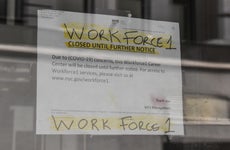Unemployment vs. underemployment, explained

The Bankrate promise
At Bankrate we strive to help you make smarter financial decisions. While we adhere to strict , this post may contain references to products from our partners. Here's an explanation for .
Even if every American who wants a job can find one, that doesn’t always mean the labor market is at its strongest.
Underneath the surface is another important part of the employment picture: Whether workers can find a position that matches their skill sets and availability. If they can’t, economists commonly refer to them as “underemployed” — and even if joblessness isn’t widespread, a lack of opportunities suiting workers’ skills can often be just as economically unproductive.
So-called “underutilization” rates are lower today than they were before the pandemic, according to data from the Department of Labor. Yet, underemployment is nearly two times as high as joblessness.
Here’s what that means for your wallet and the economy — and what to do if you find yourself in this position.
Unemployment vs. underemployment: The difference
Unemployment is perhaps the most commonly discussed labor market indicator, showing how many individuals in the workforce have been looking for a job but haven’t yet found one. The fewest number of Americans in 53 years are currently jobless, with the unemployment rate sinking to 3.4 percent, an even lower level than before the pandemic.
Underemployment, however, happens when someone isn’t employed in a position that utilizes their full potential. Most economists would say someone is underemployed if they’re working part time for economic reasons or stuck in a low-skilled position even though they have special training and experience.
Say someone has a master’s degree in finance but has been working as a cashier at a retail store because they can’t find a position in their field. Maybe another individual has been working part time but would prefer a full-time job. Technically, individuals in those two scenarios would be counted as employed. But their presence alone might question the strength of the labor market’s prospects.
Labor economists often look at a different measure of labor underutilization — commonly called the “U-6 rate” — when trying to track underemployment. In January 2023, that rate stood at 6.6 percent, among some of the lowest levels on record.
Causes of underemployment
A working individual might face a number of barriers while trying to find a position that matches their capabilities and potential. Those include:
- Cyclical unemployment: When the labor market is recovering from a recession, unemployed individuals often outnumber the availability of open positions, leading to both high levels of unemployment and underemployment.
- Technological advancement: Some individuals might have been displaced by new technologies or programs that made the position for which they were trained more obsolete.
- Recent college graduates: Data from the New York Fed shows recent college graduates face higher underemployment rates than college graduates overall as they transition to the better-paying positions they studied in school.
- Institutional barriers and discrimination: According to the left-leaning Economic Policy Institute, younger workers as well as Black and Hispanic individuals face higher underemployment rates. Others may cut back on their working hours to care for children.
Why underemployment matters for workers and the economy
Underemployment can matter both for economic and personal reasons. More broadly, if large swaths of the labor force would prefer to work full time or are working a position for which they are overqualified, it means the U.S. economy isn’t close to its full productive capacity, weighing on growth.
From a career perspective, underemployment might set individuals back on skill development or career advancement. The longer they’re away from their desired field, individuals might also start to lose key skills.
Other Americans might feel hard-pressed to afford basic necessities, going as far as working multiple jobs to make ends meet, facing poverty or being unable to afford bills. A January Bankrate survey found that many individuals were living paycheck to paycheck, even before the coronavirus pandemic hit.
Lower underemployment? One reason could be tied to the labor shortage
One of the reasons why underemployment rates might not be so high in today’s red-hot labor market: Labor supply isn’t matching up with the amount of demand for new workers.
As the economy bounced back from the coronavirus pandemic, businesses added positions back at a record rate — but workers didn’t come back as quickly. As of December 2022, employers had 11 million job openings, among the highest levels ever recorded and nearly twice as high as the number of unemployed Americans (5.7 million), according to the Labor Department. Businesses have also created a whopping 5 million jobs over the past 12 months, two and a half times faster than 2019’s pace.
Even so, about 3.5 million workers are missing from the labor force since February 2020, depressing already robust job creation, based on a Federal Reserve analysis.
The question, however, is how long the strong job market could last. Economists in a Bankrate survey foresee joblessness surging to 5.2 percent by January 2024, while the U.S. economy has a 64 percent chance of entering a recession in 2023.
Layoffs, meanwhile, are perking up in traditional white-collar positions that require training and schooling, such as technology and financial services. Job cuts in 2022, for example, jumped 13 percent from the prior year, according to data from Challenger, Gray and Christmas. Traditionally low-wage, service industries such as food and accommodation as well as leisure and hospitality still have the highest demand for new workers, Labor Department data shows.
Bottom line: How to avoid underemployment
Workers still have steps they can take to help bolster their earnings and employment opportunities, even in the face of a downturn.
- Build your network: Having connections with other individuals in your field can be a powerful way to build up a list of potentially valuable references — and even help you find positions through word of mouth.
- Look for ways to improve your resume: When jobs aren’t as plentiful in your field, that might mean doing everything you can to improve both your work experience and skills. That includes new vocational training or taking on new tasks that might make you a more competitive candidate.
- Search regularly for your ideal position: Finding a job that matches your skill sets first starts with knowing what you want and then seeing whether it’s out there for you.
A job market that doesn’t provide workers with the right opportunities weighs on more than just their career development — but also their ability to afford everyday expenses. Saving a cushion of cash for emergencies can help give you the peace of mind to weather any kind of economic storm and even be careful about choosing the right opportunity during a period of unemployment.
“While the unemployment rate has remained historically low, too many Americans continue to live paycheck to paycheck,” says Mark Hamrick, Bankrate senior economic analyst. “It is especially concerning because we’re on high alert for the possibility of a recession when jobs would be lost.”
Related Articles

Is the U.S. economy in a recession or depression? Here’s what top economists say

Unemployment or recession fears aren’t stopping workers from making career moves

The unemployment rate, explained – and why the coronavirus crisis has caused it to skyrocket

Survey: Economists see unemployment surging to 4.5% and sharp job growth slowdown